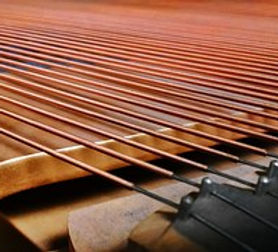top of page
MUSIC TO A SPIDER'S FEET

This project is run by Dr. Hatton of Oregon State University. The goal is to create a computational model of spiderweb vibrations. The model will help biologists understand spiders' building habits by relating web geometry and material to vibration transmission.
We constructed "Charlotte" and her 4 ft (1.2 m) model web for preliminary experiments. Charlotte's design was my focus: she is made to hold an array of accelerometers which sense the distribution of vibration in the model web.
The web will be used for engineering outreach, so we decided to give her a fine arachnid public figure.
Thanks to the NSF for funding my stay at OSU!
See BBC article about this research: http://www.bbc.com/news/science-environment-35849341

Charlotte in her web
 Kenzi and me with our first prototype. We thought that using foam for Charlotte's body would damp vibrations between the legs. (As much as possible we wanted separate readings at each foot.) We used a stress ball as the body to test this foam theory, but it turned out that mass was a much better damper for high frequency vibrations than foam was. Charlotte's final design included a steel weight for extra damping. |  Charlotte's body was 3D printed from parts designed in SolidWorks. I rearranged the supports from an umbrella to make her legs. |  Our REU poster |
|---|---|---|
 Charlotte on the paracord web constructed by our teammates. Each radial strand of the web is connected to a ratchet so that the web can be put in tension evenly. |  Inside Charlotte: We printed Charlotte's body in several parts to avoid excess support material and to ease assembly and wire insertion. The inner (green) support mimics the design of an umbrella crown - we didn't see any point in reinventing the wheel. The outer shell gathers and routes the accelerometer wires out Charlotte's derriere. (Or rather, out her spinneretes!) |  We chose to use accelerometers to take data on the web vibrations. We considered using Hall Effect sensors (such as are used in electric guitar pick-ups), but the accelerometer is more appropriate since it can offer information from the vibrating string without any external reference frame. |
 Testing the accelerometer: At left is raw accelerometer data I took from a vibrating string (using an Arduino). I ran the data through a Fast Fourier Transform in Matlab to find the amplitude of different frequencies in a vibrating string. The second graph shows the results - it looks like the string was vibrating at a pretty pure 60 Hz. |
bottom of page